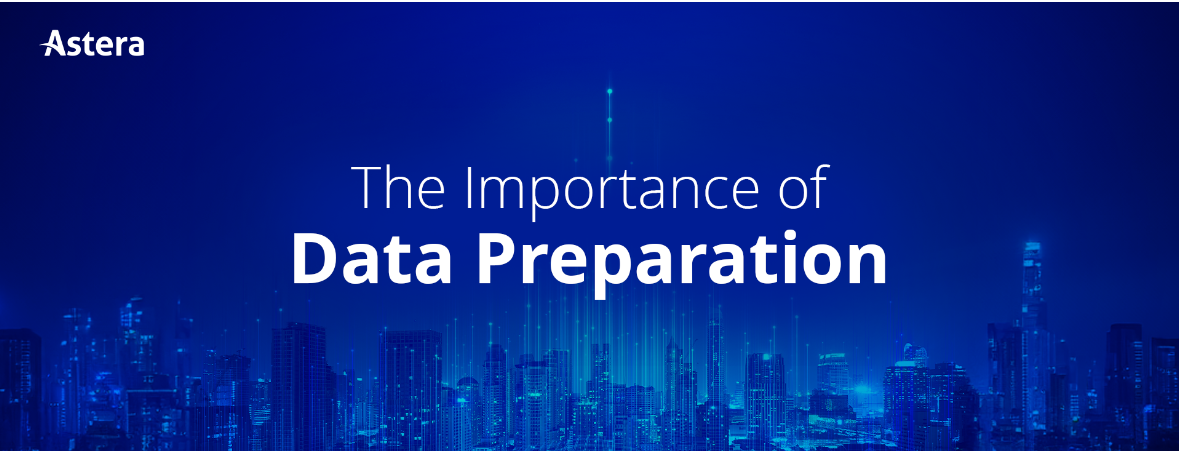
What Is Data Preparation? Comprehensive Guide + 9 Steps For Effective Data Prep
A survey found that 76% of data scientists consider data preparation their least favorite part of their job, and a majority of their time is spent on data preparation.
Nevertheless, data preparation is necessary to make raw data ready for analysis and consumption and helps gain valuable insights from your data.
So, how can you prepare data without spending several hours wrangling it? This comprehensive data preparation guide goes over the concept, its importance, benefits, challenges, data prep tools, and a step-by-step walkthrough on how to perform data preparation. Bonus: a section on data preparation in the cloud and why you should consider it!
What Is Data Preparation?
Data preparation (also known as data prep) is the essential process of refining raw data to make it suitable for analysis and processing. Raw data, which is filled with errors, duplicates, and missing values, impacts data quality and, ultimately, data-driven decision-making.
Data preparation is crucial as it can consume up to 80% of the time in a machine learning project. Utilizing specialized data preparation tools is imperative to streamline and optimize this process.
According to surveys by Anaconda and Forbes, data scientists spend 45-60% of their time collecting, organizing, and preparing data, with data cleansing accounting for more than a quarter of their day. This takes valuable time away from their core tasks, such as model selection, training, and deployment. Therefore, many question the wisdom of asking highly skilled data scientists to do the equivalent of digital janitorial work.

[Data Preparation Challenges via Statista]
Why is Data Preparation Necessary?

Raw data is messy, incomplete, and inconsistent. Additionally, it is spread across diverse sources, formats, and types. Data preparation helps businesses by:
Extracting Unstructured Data
Data preparation is essential for extracting data from unstructured sources such as PDFs, .TXT, .CSV, etc. Data preparation involves converting unstructured data into a format suitable for analysis and unlocking insights from diverse sources.
For example, preparing data can help you extract financial data from PDFs and CSV files to analyze trends and patterns in revenue, expenses, and profits. By converting unstructured data into a structured format, data preparation enables comprehensive data analysis that can reveal hidden insights and opportunities.
Enhancing Data Quality
Data preparation improves data quality by rectifying errors, inconsistencies, missing values, outliers, and more. It also validates and verifies data to ensure correctness and completeness. For example, effective data quality management can prevent inaccurate analysis by removing duplicate entries from a customer database.
Amplifying Value
Data preparation adds value to data by incorporating supplementary information like geolocation, sentiment analysis, and topic modeling. It also helps integrate data from diverse sources to form a cohesive overview. For instance, a data value can reveal customer satisfaction by adding sentiment analysis scores to feedback comments.
Facilitating Data Analysis
Data preparation makes data analysis easier by transforming data into a consistent format that is compatible with analysis tools and applications. It also helps discover patterns, trends, correlations, and other insights. For example, data analysis can simplify time-series analysis by converting various date formats into a standardized structure.
Enhancing Data Consumption
Data preparation makes data more consumable by providing metadata and documentation that ensure transparency and usability. It also shares data through APIs, web services, files, or databases, making it accessible to diverse users and applications. For instance, data consumption can improve user understanding by providing data documentation that details the origin and definitions of each field.
Now that you understand the importance of clean, healthy data, let’s dive straight into how you and your team can prepare data.
Automate your data preparation with Astera
Astera's data integration solution not only preps your data but also handles end-to-end integration for smooth, automated data pipelines.
Build your data pipeline today.What Are the Benefits of Data Preparation
Effective data preparation ensures that raw data is clean, structured, and ready for analysis. This process offers several benefits, such as:
- Improved Data Quality: Identifying and correcting errors, inconsistencies, and missing values leads to more reliable datasets for decision-making.
- More Accurate Insights: Clean and well-structured data reduces biases and improves the accuracy of analytics and machine learning models.
- Enhanced Efficiency: Automating data preparation reduces the time and effort required to clean, transform, and integrate data, allowing teams to focus on analysis rather than data wrangling.
- Seamless Data Integration: Standardizing formats and resolving discrepancies across multiple data sources enables a unified view of business information.
- Better Compliance and Governance: Proper data validation and documentation help organizations meet regulatory requirements and ensure data security.
- Increased Scalability: Well-prepared data enables businesses to scale their analytics operations efficiently without running into quality or performance issues.
9 Key Data Preparation Steps
Step 1: Defining Objectives and Requirements
You must start preparing data by defining your objectives and requirements for the data analysis project. Ask yourself the following questions:
- What is the purpose and scope of the data analysis project?
- What are the main questions or hypotheses that you want to test or explore with the data?
- Who are the intended users and consumers of the data analysis results? What are their roles and responsibilities?
- What are the data sources, formats, and types that you need to access and analyze?
- What is the quality, accuracy, completeness, timeliness, and relevance criteria you must meet for the data?
- What are the ethical, legal, and regulatory implications and constraints that you need to consider?
Answering these questions can help you clarify the goals, scope, and requirements of your data analysis project, as well as identify the potential challenges, risks, and opportunities that you may encounter along the way.
Step 2: Collecting Data
Next, you must collect data from various sources, such as files, databases, web pages, social media, and more. Use reliable and trustworthy data sources to provide high-quality and relevant data for your analysis.
Feel free to leverage appropriate tools and methods to access and acquire data from different sources, such as web scraping, APIs, databases, files, etc.
Gathering data from multiple sources helps you gain a more comprehensive and accurate understanding of your business problem. Different sources may provide different types of data, such as quantitative or qualitative, structured or unstructured, or primary or secondary.
Moreover, gathering data from multiple sources helps you reduce bias and increase the reliability and validity of your data. At the same time, gathering data from multiple sources helps you identify new opportunities and potential threats You can gain insights into market trends, industry performance, customer behavior, and competitor strategies.
Step 3: Integrating and Combining Data
Data integration means combining data from different sources or dimensions to create a holistic view of the data. It helps you merge your data to create a comprehensive and unified dataset.
Data integration tools can perform operations such as concatenation, union, intersection, difference, join, etc. They can also handle different types of data schemas or structures.
However, you must consider several key practices while integrating and combining data. First, you must use a common standard format and structure for storing and organizing your data. Formats like CSV, JSON, or XML provide consistency and make data more accessible and understandable.
You must also centralize your data storage and management using options like cloud storage, a data warehouse, or a data lake. A centralized platform streamlines data access, ensures data consistency, and simplifies data governance.
In addition, you must ensure security and reliability in the data management process. Employ robust measures like encryption, authentication, authorization, backup, recovery, and audit mechanisms. Encryption safeguards data in transit and at rest, while authentication and authorization control access to sensitive information.
Step 4: Profiling Data
Data profiling is the process of examining a dataset to gain an in-depth understanding of its characteristics, quality, structure, and content. It helps users uphold data quality standards within an organizational framework. At its core, data profiling helps ensure that data columns adhere to standard data types, thus giving the dataset an added layer of precision.
Ultimately, data profiling helps uncover insights into the uniformity of data or any discrepancies that might be present, including null values. Initially, you must review source data, check for errors, inconsistencies, and anomalies, as well as understand the structure, content, and relationships of files, databases, and web pages.
Moreover, you must review aspects such as:
- Completeness.
- Accuracy.
- Consistency.
- Validity.
- Timeliness.
Create a comprehensive data profile by summarizing source data details, incorporating metadata, statistics, definitions, descriptions, and sources, and documenting formats, types, distributions, frequencies, ranges, outliers, and anomalies.
Step 5: Exploring Data
Data exploration is the process of getting familiar with your data and discovering its characteristics, patterns, trends, outliers, and anomalies. Data exploration can help you understand your data better and assess its quality and suitability for your analysis objectives.
As you explore the data, you must identify and categorize data types, formats, and structures within your dataset. Next, you must overview descriptive statistics, noting measures like the mean, median, mode, and standard deviation for each relevant numerical variable.
Leveraging visualizations such as histograms, boxplots, and scatterplots can give you insights into data distributions and underlying relationships and patterns. You can also use more advanced methods such as clustering, dimensionality reduction, and association rules to unearth hidden trends, identify correlations, highlight outliers, and reveal anomalies. Likewise, it’s equally important to evaluate how relevant the data is to what you want to learn.
Step 6: Transforming Data
Data transformation converts data from one format, structure, or value to another, playing a pivotal role in the data preparation journey by rendering data more accessible and conducive to analysis.
Data transformation makes source data more compatible with the destination system and application, making it easier to analyze and consume. There are several techniques to transform data, such as normalization, aggregation, and filtering—and how you apply these transformations depends on the use case.
For instance, in a sales dataset, data normalization can help you standardize prices to a common currency. Simultaneously, payment methods are categorized into uniform formats, such as changing “CC,” “Visa,” or “MasterCard” to “credit card”.
Step 7: Enriching Data
Data enrichment is the process of refining, improving, and enhancing a dataset by adding new features or columns. It helps to improve the accuracy and reliability of raw data. Data teams enrich data by adding new and supplemental information and verifying the information against third-party sources.
- Append data by combining multiple data sources, including CRM, financial, and marketing data, to create a comprehensive dataset that provides a holistic view. This enrichment technique also involves integrating third-party data, such as demographics, to enhance insights.
- Segment data by grouping entities like customers or products based on shared attributes, utilizing standard variables such as age and gender to categorize and describe these entities.
- Engineer new features or additional fields by deriving them from existing data. For instance, you can calculate customer age based on their birthdate.
- Address missing values by estimating them from available data. For instance, you can calculate absent sales figures by referencing historical trends.
- Identify entities like names and addresses within unstructured text data, extracting actionable information from text that lacks a fixed structure.
- Assign specific categories to unstructured text data, such as product descriptions, or categorize customer feedback to enable analysis and gain insights.
- Leverage various enrichment techniques to enhance your data with additional information or context, such as geocoding, sentiment analysis, entity recognition, topic modeling, etc.
- Use cleaning techniques to remove or correct errors or inconsistencies in your data, such as duplicates, outliers, missing values, typos, formatting issues, etc.
- Use validation techniques to verify or confirm the correctness or completeness of your data, such as checksums, rules, constraints, tests, etc.
Step 8: Validating Data
To ensure data accuracy, completeness, and consistency, you need to perform data validation before finalizing data for consumption. Data validation will enable you to check data against predefined rules and criteria that reflect your requirements, standards, and regulations. The following steps can help you conduct data validation effectively:
- Analyze the data to understand its characteristics, such as data types, ranges, and distributions. Identify potential issues like missing values, outliers, or inconsistencies.
- Select a representative sample from the dataset for validation. This step is beneficial for large datasets, as it reduces the processing load.
- Apply the predefined validation rules to the sampled data. Rules can include format checks, range validations, or cross-field validations.
- Identify records that fail to meet the validation rules. Record the nature of errors and inconsistencies for further analysis.
- Correct identified errors by cleaning, transforming, or imputing data as necessary. Maintaining an audit trail of changes made during this process is essential.
- Automate data validation processes to ensure consistent and ongoing data quality maintenance whenever possible.
Step 9: Documenting and Sharing Data
Lastly, you must provide metadata and documentation for your data, such as definitions, descriptions, sources, formats, and types. Your data should be accessible and usable by other users or applications before consumption.
- Use metadata standards and formats to provide metadata for your data, such as Dublin Core, Schema.org, JSON-LD, etc.
- Leverage documentation tools and methods to provide documentation for your data, such as README files, comments, annotations, etc.
- Use data catalog tools and platforms to organize and manage your data and metadata.
- Leverage data sharing tools and methods to make your data available and accessible by other users or applications, such as APIs, web services, files, databases, etc.
What Are The Challenges of Data Preparation
Despite its benefits, data preparation comes with several challenges:
- Data Quality Issues: Raw data often contains duplicates, missing values, and inconsistencies, requiring extensive cleaning before it can be used effectively.
- Diverse Data Sources and Formats: Organizations deal with structured and unstructured data from multiple sources (databases, APIs, spreadsheets, PDFs, etc.), making integration complex.
- Time-Consuming Process: Manual data preparation can take up a significant portion of an analyst’s time, delaying insights and decision-making.
- Scalability Limitations: Handling large volumes of data across different platforms and formats requires robust tools and infrastructure.
- Compliance and Security Risks: Managing sensitive information while ensuring compliance with regulations like GDPR and HIPAA adds another layer of complexity.
- Lack of Standardization: Inconsistent data preparation practices across teams can lead to discrepancies and unreliable analysis.
Data Preparation Tools: What to Look For
Data preparation tools can be standalone or part of unified data stacks that help organizations streamline data preparation by simplifying and automating the process. These tools offer features such as:
- Automated Data Cleaning – Identifies and fixes errors, duplicates, and inconsistencies with minimal manual intervention.
- Data Integration Capabilities – Combines data from multiple sources, including databases, cloud storage, APIs, and files.
- Transformation and Enrichment – Standardizes formats, applies business rules, and enhances datasets with additional context (e.g., geolocation, sentiment analysis).
- User-Friendly Interfaces – No-code and low-code platforms empower non-technical users to prepare data without extensive programming knowledge.
- Scalability and Performance Optimization – Enables processing of large datasets efficiently with distributed computing and cloud-based solutions.
- Collaboration and Governance Features – Provides metadata management, documentation, and access control to maintain consistency and compliance.
What is Data Preparation in the Cloud?
Considering how important data prep is for the overall data integration and analytics process, data prep in the cloud is picking up steam. Cloud-based data preparation offers several advantages, such as on-demand scalability, flexibility, easy integration through APIs and cloud storage, and real-time data processing.
Plus, prepping your data in the cloud also offers cost benefits as your data team can utilize the compute resources that may be required without having to burden significant upfront costs.
Astera Makes Data Preparation Easy and Effective
Data preparation is a vital step in the data analysis process, as it ensures the quality and reliability of the data for modeling and decision-making. However, organizations need a tool that simplifies data preparation.
Astera is a no-code data integration solution that can help your organization achieve more with your data with the ability to data prep in the cloud.
With Astera, you can:
- Effortlessly prepare your data in the cloud for effortless scalability and flexibility while also ensuring seamless connectivity and integration. With Astera, you can transform, clean, and validate your data in real-time without burdening your on-premise infrastructure.
- Empower non-technical users to access and manipulate data without coding. Astera lets you perform various data tasks with user-friendly interfaces and pre-built templates. You can integrate, cleanse, transform, and enrich data with ease and efficiency.
- Streamline and accelerate the data preparation process. Astera reduces the need for IT or data engineering intervention, allowing you to handle your data needs independently. With Astera, you can save time and money by automating and simplifying data workflows.
- Ensure data accuracy and consistency. Astera provides tools for data validation and quality checks. You can detect and correct errors, ensuring that your data is reliable and ready for analysis.
- Facilitate collaboration. Astera allows multiple users to work on data preparation projects simultaneously. You can share and reuse data assets, enhance productivity, and foster cross-functional teamwork.
With Astera, you can transform your data into valuable insights faster and more easily than ever before. Learn more about data preparation tools and how Astera simplifies data prep.
Ready for a demo? Let’s connect!
 Astera AI Agent Builder - First Look Coming Soon!
Astera AI Agent Builder - First Look Coming Soon!


